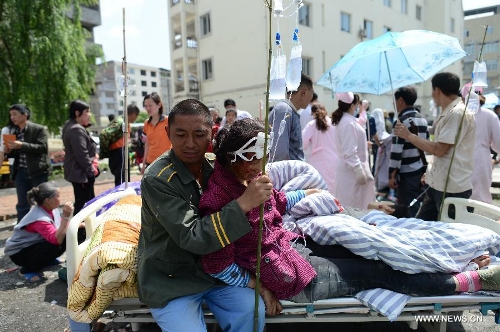7.0-magnitude earthquake hits SW China's Sichuan
Latest News: The 7.0-magnitude earthquake in Sichuan has left 113 people dead and over 3,000 injured.

A 7.0-magnitude earthquake hit Lushan county of Ya'an city in Southwest China's Sichuan Province at 8:02 am Saturday Beijing Time, according to the China Earthquake Networks Center (CENC).
The epicenter, with a depth of 13 km, was monitored at 30.3 degrees north latitude and 103.0 degrees east longitude.
The quake was strongly felt by residents in Sichuan's capital city of Chengdu, which is about 140 kilometers from Ya'an.
A resident in Chengdu, who was on the 13th floor of a building when the quake occurred, said he felt the building shaking for about 20 seconds and he saw tiles fall off nearby buildings.
People in Leshan city of Sichuan Province, and neighboring Chongqing Municipality also felt the earthquake.
The quake was also felt in provinces of Guizhou, Gansu, Shaanxi and Yunnan.
Multiple aftershocks jolted the area after the 7.0 magnitude quake took place, the largest aftershock in magnitude being the 5.1-magnitude one which shook the bordering area of Lushan and Baoxing counties of Sichuan at 8:07 a.m..
Till the time of release, several aftershocks rated above 4.0-magnitude hit the area, including a M-4.8 quake at 8:06 am, a M-4.6 one at 9:02 am a M-4.1 one at 8:31 am, and a M-4.1 on at 8:37.
Related articles: Over 2,000 soldiers rush to quake-hit area for rescue
Chinese leaders order all-out efforts to save lives after M-7.0 quake
Doctors, police, firefighters dispatched to quake-hit Ya'an
Firefighters rescue 27 quake survivors, relief materials dispatched
Xi orders rescuing troops to make "every possible effort"
Commentary
Five years of progress pays off in lives: Tao Duanfang, media commentator
Five years ago when the Wenchuan earthquake struck, rescue teams rushing to the scene fought a brave battle against the natural disaster, armed only with passion and enthusiasm. In the race to save lives, they were hampered by a lack of machinery, professional equipment and expertise.
But this time when the Ya'an earthquake rocked Sichuan again, both governments and ordinary people were far better prepared for disaster relief work, equipped with advanced GPS, specialized vehicles and large machinery. Such improvements, though still inadequate, offer comfort to those waiting to be rescued.
But much is still left to be desired after five years.
Mismanaged traffic control in quake-stricken areas, which caused traffic jams five years ago, is even worse five years later. Though some of the blame lies at the local level, where some toll gates were still charging passing vehicles after the quake and with some individual rescuers, as a lot of private cars crowded the roads and blocked the way of professional rescue vehicles, the lion's share belongs to the government, letting us down with slow response and poor coordination. By the time the transportation department of Sichuan Province issued an order to set up an emergency lane for the exclusive use of rescue vehicles, over 10 precious hours had lapsed. The government was also caught flat-footed by the soaring car ownership as well as the rush by the public to help, which, to some extent, has made traffic control in stricken areas more difficult.
Trivial turns to passion: China Youth Daily
This time, the self-organizing ability, solidarity and rationality shown on the Internet is a source of strength, especially to those who feel helpless in disasters. New media and social networks widely deplored for their obsession with entertainment turn into a force for good as people stop recreational activities and come together for disaster relief; Weibo, bubbling with inflammable emotions as a breeding ground of squabbles and shouting-matches, cools down as people discard differences and biases and rally behind relief efforts.
Social networking, in short, has become a powerful force in disaster relief as it is being more skillfully used to seek the missing or help those waiting for rescue.
Wide rescue: Beijing News
Rescue is a word with wide connotations, encompassing mutual- and self-assistance and all the services of relief work. Mutual- and self- rescue mean helping each other and protecting oneself in stricken areas; national rescue refers to efforts by the government to mobilize all the resources available, save everyone in distress and ensure information transparency; providing services for relief efforts, however, is something all the Chinese people can do after the Ya'an earthquake.
Confronting rumor: Official Weibo of People's Daily
Compounded by panic and confusing information, every disaster has the potential to breed rumors. The detention of a man who falsely claimed “Chengdu is in for a bigger earthquake” serves as a cautionary tale that the world of new media calls for a cooler head to resist rumors. Meantime, rumors can be nipped in the bud by the government releasing timely and authoritative information, which is also a form of disaster relief.